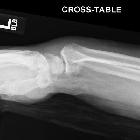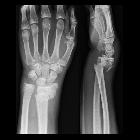Smith-Fraktur










Smith fractures, also known as Goyrand fractures in the French literature , are fractures of the distal radius with associated volar angulation of the distal fracture fragment(s). Classically, these fractures are extra-articular transverse fractures and can be thought of as a reverse Colles fracture.
The term is sometimes used to describe intra-articular fractures with volar displacement (reverse Barton fracture) or juxta-articular fractures .
Epidemiology
Smith fractures account for less than 3% of all fractures of the radius and ulna and have a bimodal distribution: young males (most common) and elderly females .
Pathology
Smith fractures usually occur in one of two ways:
- a fall onto a flexed wrist
- direct blow to the back of the wrist
Radiographic features
The fracture can be split into three types, although in practice a description suffices :
- type I
- extra-articular transverse fracture through the distal radius
- most common: ~85%
- type II
- intra-articular oblique fracture
- equivalent to a reverse Barton fracture
- ~13%
- type III
- juxta-articular oblique fracture
- uncommon: <2%
Plain radiograph
In most instances, a plain wrist radiographic series will suffice for diagnosis and characterization. The fracture line is usually evident, although in undisplaced of mildly impacted fractures it can be difficult to see and subtle cortical breaches/buckling should be sought. In intra-articular fractures (type II) the degree of articular step-off and gap should be assessed, and this may require CT.
Radiology report
Reporting checklist
In addition to reporting the presence of a distal radial fracture with volar angulation a number of features should be sought and commented upon:
- fracture
- location (extra-, juxta- or intra-articular)
- degree of angulation
- degree of displacement
- carpus
- ensure no carpal malalignment or fractures are present
- assess articulation of radio-lunate and radio-scaphoid joint
Treatment and prognosis
Treatment depends on the type of fracture, stability and ability to successfully reduce the fracture. In most cases, these fractures can be treated with closed reduction and cast application .
If the fracture can be reduced but remains unstable, or cannot be reduced then operative fixation (ORIF) is usually required .
Malunion, with a residual volar displacement of the distal radius results in a cosmetic deformity, referred to as a garden spade deformity. More importantly, it also narrows and distorts the entry to the carpal tunnel and can result in carpal tunnel syndrome .
History and etymology
First named for Jean-Gaspard-Blaise Goyrand, French physician (1746-1814) .
Named by Robert William Smith (1807-1873) who was a surgeon in Dublin, Ireland. He succeeded Abraham Colles (Colles fracture) as Professor of Surgery at Trinity College, Dublin.
See also
Siehe auch:
- Colles-Fraktur
- Galeazzi-Fraktur
- Frakturen mit Eigennamen
- Chauffeur-Fraktur
- Monteggia-Fraktur
- Barton Fraktur
- distale Radiusfraktur
- Essex-Lopresti fracture
- reverse Barton fracture
- Karpaltunnelsyndrom
- Luxationsfrakturen von Radius und Ulna
und weiter:

 Assoziationen und Differentialdiagnosen zu Smith-Fraktur:
Assoziationen und Differentialdiagnosen zu Smith-Fraktur:








